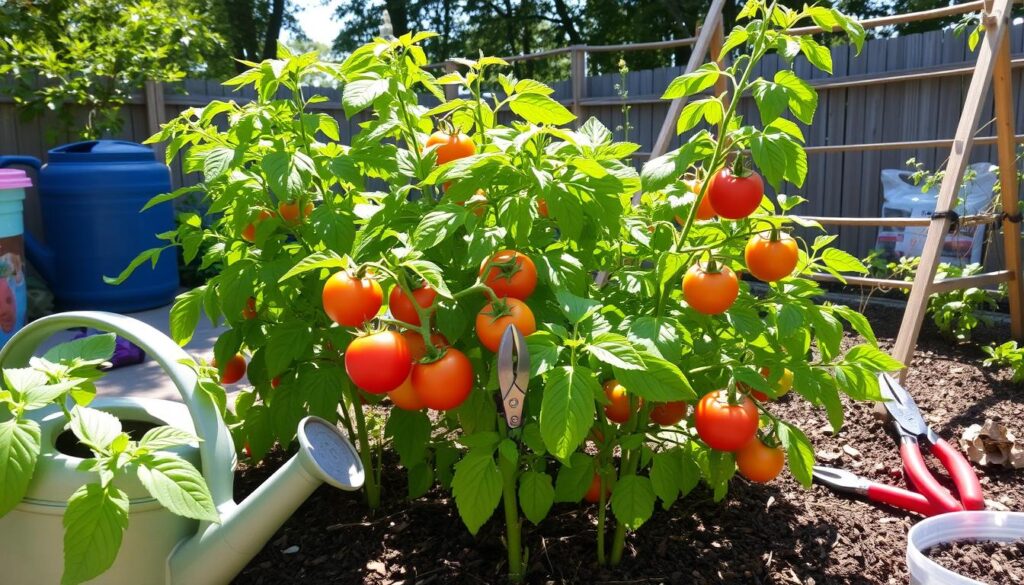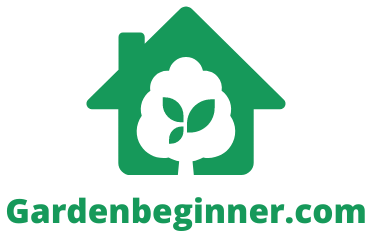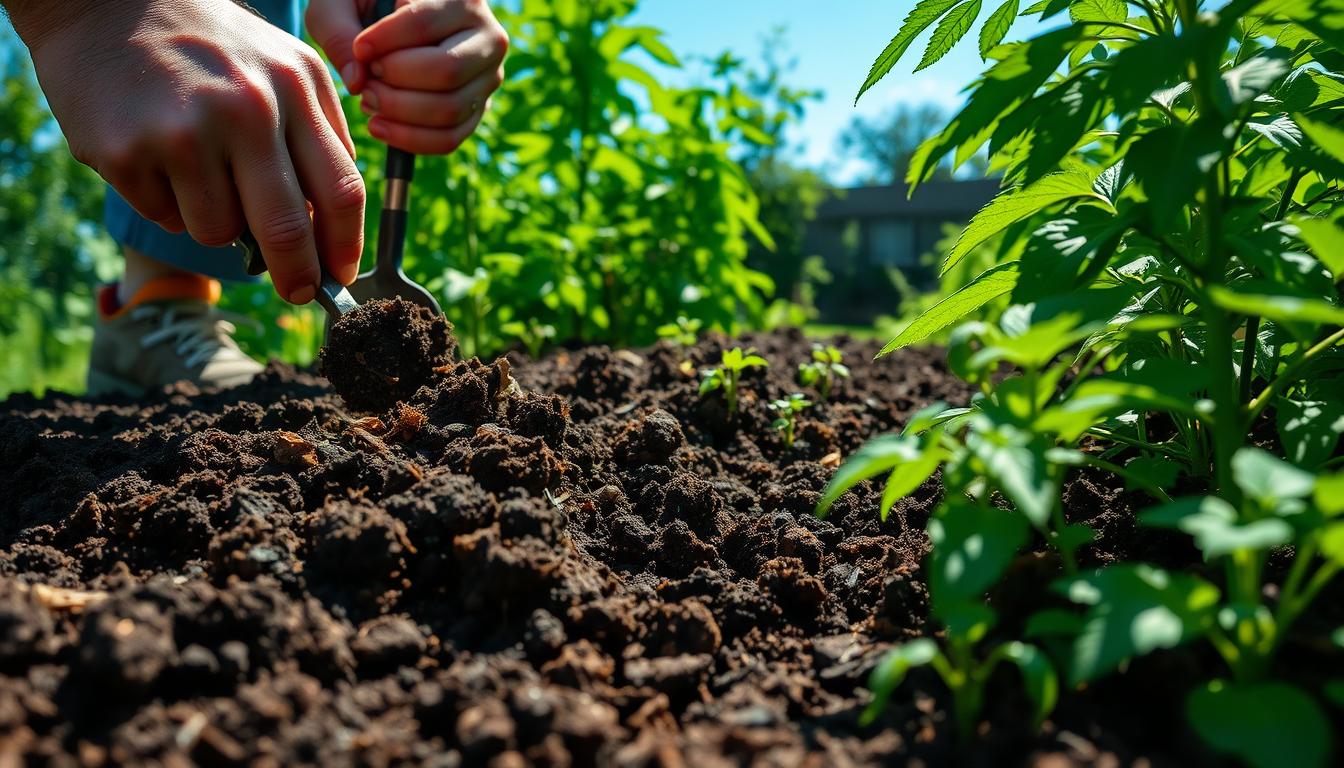I’m excited to share my gardening knowledge with you. We’ll learn how to grow tasty, juicy tomatoes in your backyard. This guide is for everyone, whether you’re new to gardening or have experience. We’ll cover everything from picking the right tomatoes to caring for them.

Key Takeaways
- Discover the secrets to growing thriving tomato plants in your backyard
- Learn how to select the best tomato varieties for your growing conditions
- Understand the essential steps for preparing the ideal growing environment
- Master the techniques for planting, caring for, and harvesting your tomatoes
- Explore strategies to extend your tomato growing season and maximize your yields
Introduction: Why Grow Your Own Tomatoes?
Growing your own tomatoes brings many benefits. It’s not just about gardening. You get to enjoy garden-fresh flavor and the joy of growing your own sustainable food. Starting a tomato patch in your backyard is a great idea.
One big plus of growing tomatoes is their amazing taste. Store-bought tomatoes can’t compare to the rich, juicy flavors of homegrown ones. Growing your own tomatoes means you get to taste the full, vibrant flavors that commercial tomatoes can’t match. This garden-fresh flavor makes your cooking even better.
Another benefit is the joy of sustainable gardening. By growing your own tomatoes, you help the environment. You reduce your carbon footprint, cut down on food waste, and control the quality of your food. It’s a fulfilling way to live more sustainably and be self-sufficient.
“Growing your own tomatoes is a truly rewarding experience that connects you to the land and provides an unparalleled level of freshness and flavor.”
Whether you love gardening or just want to eat more homegrown produce, growing tomatoes is worth it. Next, we’ll look at how to pick the best tomato varieties and create the perfect growing space for a great harvest.
Selecting the Right Tomato Varieties
Choosing the right tomato variety is key to growing tasty tomatoes in your backyard. Tomatoes fall into two main types: determinate and indeterminate. Knowing the difference helps you pick the best tomatoes for your garden and climate.
Determinate vs. Indeterminate Tomatoes
Determinate tomatoes are known as “bush” or “semi-determinate” varieties. They grow compactly and stop growing once they reach a certain height. These tomatoes are great for canning and are perfect for small gardens.
Indeterminate tomatoes are vining plants that keep growing and producing fruit all season. They can grow very tall and need support. These tomatoes give you a steady supply of fresh tomatoes for a long time.
Heirloom vs. Hybrid Varieties
When picking tomato varieties, you also have to decide between heirloom and hybrid. Heirloom tomatoes are old varieties with unique looks and tastes. They taste amazing but might get sick easier and don’t last long.
Hybrid tomatoes are made by crossing different tomato plants. They’re bred for better disease resistance, more fruit, and longer shelf life. While they might not taste as rich as heirlooms, they’re a good choice for home gardens.
Understanding the differences between determinate and indeterminate, and heirloom and hybrid tomato varieties, helps you choose wisely. Try different types to find the perfect tomatoes for your garden.
Preparing the Ideal Growing Environment
To grow great tomato plants, start with the right soil. Learning about tomato soil preparation is key. We’ll cover how to make the best soil for your tomatoes.
Soil Requirements and Amendments
Tomatoes love soil that drains well and is rich in nutrients. The ideal pH is between 6.0 and 6.8. First, test your soil to see where it stands. This will help you pick the right soil amendments.
After getting your soil test results, start adding the right stuff. Use compost, aged manure, and lime or sulfur to adjust pH. These will give your tomatoes the nutrients they need and make the soil better for them.
| Soil Amendment | Purpose | Recommended Amount |
|---|---|---|
| Compost | Improve soil structure and fertility | 2-4 inches mixed into the top 6-8 inches of soil |
| Aged Manure | Provide additional nutrients | 1-2 inches mixed into the top 6-8 inches of soil |
| Lime or Sulfur | Adjust soil pH | Refer to soil test results for recommended application rate |
By preparing the perfect tomato soil, your plants will grow strong. This means a big harvest of tasty tomatoes.
“The key to growing successful tomatoes is understanding the importance of soil preparation. With the right amendments, you can create the perfect environment for your plants to flourish.”
Planting Tomatoes: Step-by-Step Guide
Planting your tomato seedlings right is key to a great harvest. Follow these easy steps to help your plants grow well in your garden.
Timing is Key
Transplant your tomato seedlings after the last frost, usually 4-6 weeks after the average last frost date. This makes sure the soil is warm enough for them to grow well.
Spacing and Depth
When planting tomatoes, put them 18-24 inches apart in rows 3-4 feet apart. Dig a hole deeper than the seedling’s root ball. Gently put the seedling in, burying the stem up to the first leaves. This helps the plant grow a strong root system.
Transplanting Seedlings
- Carefully remove the seedling from its container, being careful not to damage the roots.
- Loosen the soil in the planting hole and place the seedling, ensuring the stem is buried up to the first set of leaves.
- Gently firm the soil around the plant to stabilize it and water thoroughly.
Proper tomato planting and transplanting seedlings with the right spacing and depth will give your plants the best timing for a successful growing season.
The Ultimate Guide to Growing Tomatoes in Your Backyard
Growing tomatoes in your backyard is a rewarding hobby. It can give you a lot of fresh, tasty tomatoes. This guide will help you become a great backyard tomato grower, whether you’re new or experienced.
When it comes to tomato plant care, picking the right spot is key. Look for a sunny area that gets at least six hours of direct sunlight a day. Make sure the soil drains well and is rich in nutrients. Add compost or organic matter to your soil before planting.
Understanding tomato varieties is important for backyard tomato cultivation. Determinate tomatoes grow to a certain height and ripen all at once. They’re great for canning. Indeterminate tomatoes keep growing and producing fruit all season. They’re perfect for eating fresh.
- For growing techniques, use stakes or cages to support the tomatoes. This keeps them off the ground.
- Watering and fertilizing regularly are crucial for healthy plants.
- Prune and remove suckers to increase fruit and air circulation. This helps prevent disease.
“Growing your own tomatoes is one of the most rewarding experiences in the garden. The flavor and freshness of homegrown tomatoes is unmatched.”
By following these tips, you’ll have a thriving tomato patch in no time. Enjoy the process of tomato plant care and the bounty of your harvest.
Caring for Tomato Plants
Proper care is key for healthy tomato plants. I’ll show you how to water, fertilize, prune, and stake them. This will help your tomatoes grow well in your backyard.
Watering and Fertilizing
Watering your tomato plants right is crucial. They need about 1-2 inches of water each week. Make sure not to overwater to avoid root rot. Also, the right fertilizer can boost their growth. Use a balanced, tomato-specific fertilizer and follow the instructions.
Pruning and Staking
Pruning and staking help your tomato plants grow strong. Remove suckers to focus energy on fruit. Staking or caging supports the plant and keeps fruit off the ground.
| Tomato Plant Maintenance Task | Frequency | Benefits |
|---|---|---|
| Watering | 1-2 inches per week | Prevents water stress and supports growth |
| Fertilizing | Every 4-6 weeks | Provides essential nutrients for plant development |
| Pruning | Weekly or as needed | Redirects energy to fruit production, improves airflow |
| Staking or Caging | At planting time | Supports plant growth, prevents fruit from touching the ground |
By following these tomato plant care tips, your backyard tomatoes will thrive. They’ll give you a great harvest.

“Proper tomato plant care is the foundation for a successful backyard harvest.”
Pest and Disease Management
Keeping your tomato garden healthy is crucial. It requires watching out for tomato pests and tomato diseases. As someone who gardens, I know that fighting pests and diseases early is essential for a good harvest.
The tomato hornworm is a big problem for gardeners. These green caterpillars can eat your plants, slowing them down and cutting yields. Check your plants often and remove any hornworms you see. Also, planting flowers like dill and fennel can attract wasps that eat these pests.
Tomato pests like aphids are another issue. These tiny bugs drink plant sap and can spread fast. A mix of water and insecticidal soap can kill aphids without harming your plants.
Tomato diseases like early blight and late blight are serious. They can make your plants look bad and stop them from growing. Use organic pest control like copper-based fungicides. Also, space your plants right and rotate your crops to prevent these diseases.
Knowing about tomato pests and tomato diseases helps a lot. Using organic pest control and disease prevention methods keeps your garden healthy. With some care and simple steps, you can enjoy a great harvest.
Harvesting and Storing Tomatoes
As a passionate tomato grower, I know how important it is to harvest and store tomatoes right. Knowing when they’re ripe and how to handle them ensures you enjoy their fresh taste all year.
Signs of Ripeness
Knowing when to pick your tomatoes is key for their flavor and quality. Look for these signs:
- The tomato should be a deep, vibrant red color, with no green shoulders or splotches.
- Gently squeeze the tomato; it should be slightly soft to the touch, but not mushy.
- The tomato should easily detach from the vine when you give it a gentle twist and pull.
If the tomato is still green or the skin is tough, it’s not quite ready. Wait for it to ripen more on the vine.
Harvesting and Storing Techniques
When your tomatoes are ripe, it’s time to pick and store them right. Here’s how to keep them fresh and tasty:
- Gently twist and pull the tomato from the vine, taking care not to damage the fruit or the plant.
- Handle the tomatoes with care, avoiding any bruising or crushing.
- Store ripe tomatoes at room temperature, out of direct sunlight, for up to a week.
- For longer-term storage, consider canning, freezing, or drying your tomatoes to preserve their flavor and nutrients.
By following these simple steps, you can enjoy your tomato harvest all year round.
| Storage Method | Shelf Life | Pros | Cons |
|---|---|---|---|
| Room Temperature | 1-7 days | Preserves flavor and texture | Short shelf life |
| Refrigeration | 1-2 weeks | Extends shelf life | Can affect flavor and texture |
| Canning | 1-2 years | Long-term preservation, retains nutrients | Time-consuming process |
| Freezing | 6-12 months | Retains flavor and nutrients | Texture may be affected |
| Drying | 6-12 months | Compact storage, long shelf life | Flavor and texture changes |
“The key to enjoying your homegrown tomatoes all year round is to harvest them at the right time and store them properly. By following these tips, you’ll be able to savor the fresh, garden-grown taste no matter the season.”
Extending the Tomato Growing Season
I love gardening in my backyard and always want to grow more tomatoes. There are many ways to keep my plants safe from cold weather and make them grow longer. These methods help me enjoy fresh tomatoes from my garden for more months than usual.
Using row covers or cold frames is a great way to keep tomatoes warm. These simple tools trap heat and protect plants from frost. I can make my own cold frame or buy a row cover to keep my plants cozy.
Starting tomato plants indoors and then moving them outside is another smart trick. This way, plants get a strong start and can grow and produce fruit sooner. By watching the weather, I can make sure my tomatoes grow well outside.





Leave a Reply